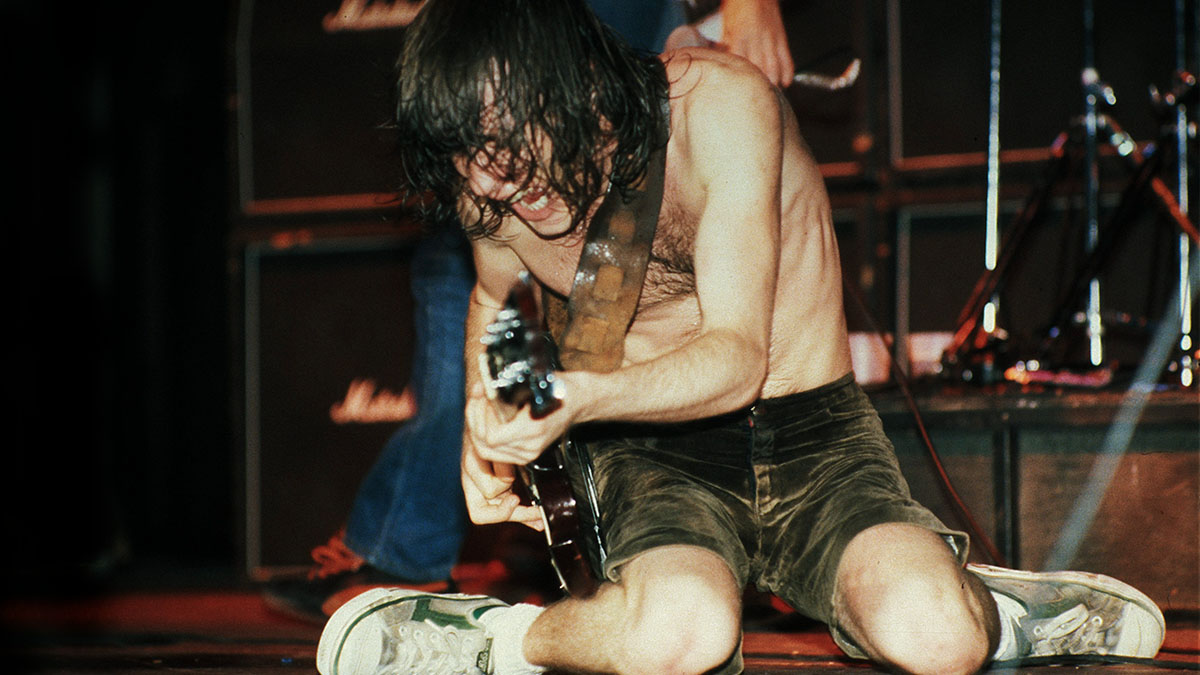“The cleaner you do it the louder it will sound:” Angus Young talks tone, solos, Malcolm and more in previously unheard interview tape from 1983
Former Guitar Player editor Jas Obrecht interviewed Angus in San Francisco for a cover feature, and he has published the hour-long conversation to his Talking Guitar podcast

AC/DC’s ninth and one of the their most underrated studio albums celebrated its 30th anniversary on 15 August, and there has been some archive gold emerging from the ether to mark the occasion, but it doesn’t get much better than a previously unheard interview with Angus Young.
Okay, the backstage footage of the band tuning up and jamming some blues, then Back In Black, with new boy behind the drums (and the perm) Simon Wright trying the trombone on for size is pretty neat, too. But an hour-long conversation, conducted by former Guitar Player editor Jas Obrecht for the cover story in the magazine’s February 1984 issue, is real gold.
The conversation took place on 22 October 1983, and takes a deep dive into Angus’s style and approach on electric guitar, with the SG-toting firebrand discussing the differences between him and his late brother, Malcolm Young, who was the undisputed king of rock ’n’ roll rhythm guitar, with a right-hand that couldn’t be more unerring had it been engineered by Soundbrenner. Angus clearly agrees, though he does downplay his own role in one of the most iconic sounds in rock.
“I’m just like a colour over the top,” said Angus. “He’s solid, and he pumps it along. His right hand is always on. And I think he is probably, in that field, I don’t think anyone could do what he does. It’s very clean. It’s very hard. It’s an attack.”
Angus reflects on how their roles have changed since the very early days. Back when they were snatching some studio time between shows to track their 1975 debut studio album, High Voltage, they would mess around and share lead duties, with Malcom laying down the solo for Little Lover.
“In the early days we used to fool around, on our first album he would do little bits of guitar, we would double up, swap, do a solo here, a solo there,” says Angus. “‘Cos Malcolm is more experienced at it than me. He knows what he is doing.”
Asked if his older brother was ever jealous that he would became the face of the band, the hyperactive school kid with the Gibson SG, duck-walking and throwing himself across the stage. No chance, says Angus, reminding us that this was all Malcolm’s idea anyway.
Get the MusicRadar Newsletter
Want all the hottest music and gear news, reviews, deals, features and more, direct to your inbox? Sign up here.
“Nah, he was the one that shoved me in in the first place,” said Angus. “He got me into it. ‘I want you to do all of this.’ … Yeah, my brother’s too lazy! Reckons it interferes with his drinking.”
Angus Young was not one for the hooch, so it was no big deal for him to stay sober and hold the audience's attention. Though he admits in this interview that playing lead guitar is the easy bit. Asked if the brothers could have switched roles, Angus is not sure. He could copy Malcolm, sure. But Malcolm could easily take on the leads.
“I look at it this way, that is the easiest part, the solos,” said Angus. “I think the hardest thing is to play together with a lot of people. I mean, when four guys hit the one note at once, very few people can do it.”
That, as they say, is the talent, the timing. And the bonus here is that we can get both sides of the AC/DC guitar story, lead and rhythm, because last month, Obrecht posted his Flick Of The Switch interview with Malcolm, conducted on the same day. You can check out these and more on the Talk Guitar YouTube channel.
Jonathan Horsley has been writing about guitars and guitar culture since 2005, playing them since 1990, and regularly contributes to MusicRadar, Total Guitar and Guitar World. He uses Jazz III nylon picks, 10s during the week, 9s at the weekend, and shamefully still struggles with rhythm figure one of Van Halen’s Panama.
“Every note counts and fits perfectly”: Kirk Hammett names his best Metallica solo – and no, it’s not One or Master Of Puppets
“I can write anything... Just tell me what you want. You want death metal in C? Okay, here it is. A little country and western? Reggae, blues, whatever”: Yngwie Malmsteen on classical epiphanies, modern art and why he embraces the cliff edge










